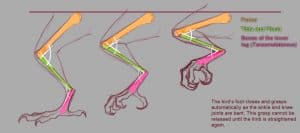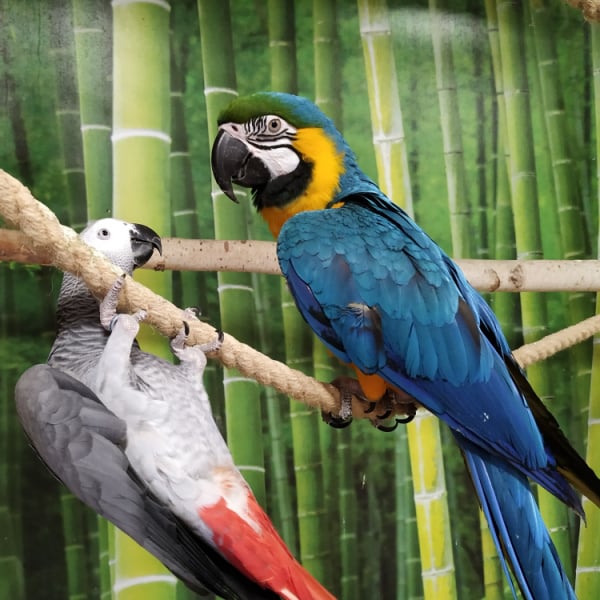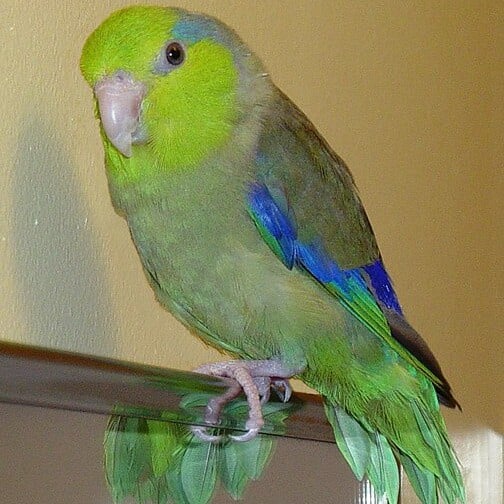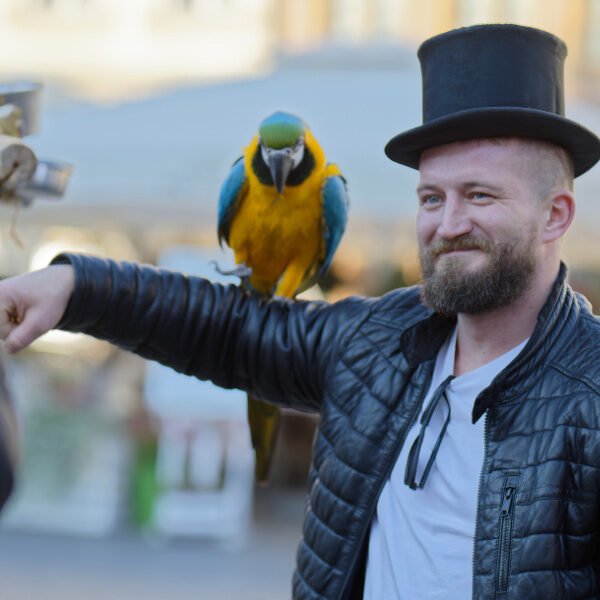Last Updated on by Catherine Tobsing
That is not really a fair question. The personality of a captive bird is determined by many factors and the environment that humans provide for them.
The bigger question is are we seeing the paratroop personality or does being a captain of birds change everything? In other words, would a bird be different in the wild than in captivity?
There is no single event, procedure, or training apparatus that will cause a bird to act like this or that, be an uncontrollable screamer, feather self-mutilation, or toe-tapper (a neurological issue in some Eclectus parrots).
Most people fail in raising captive birds because they don’t “speak bird”. It is essential to look at a pet bird holistically because every component of their life impacts their behavior.
Editors note: The questions on this page are from Quora where I “try to set the record straight”.
They tend to have a different “flavor” than the ones we get via email and help scout.
Not only is the cage set up important but what happens once the bird is out of the cage is very important – to the bird. Diet and nutrition have a major impact on a bird but so does the fact that the bird has clipped wings or is flighted. Have full-spectrum light on a timer 12 hours a day and 12 hours of darkness during the night.
Females parrots react differently than males especially when they are in their brooding mode. Then you’ll find different personalities based upon the sex of a given species.
How much foraging and enrichment is available for any particular bird is a huge factor in determining their overall personality – happy bird or sad bird.
Birds are flock animals. When you bring them into your home you (and all other household members) will become their flock. If you want to see a personality change in a parrot, add a second parrot into the mix which is what many people do thinking that they will solve the first parrot’s behavioral problems.
What ends up happening is that the two birds end up cutting you, the human out of the deal changing the dynamic from pet bird companion to zookeeper and the bird’s personalities change.
I can’t get my macaw to eat any vegetables, what should I do?
I’d start with cooked peas as they have twice as much protein as broccoli. The higher sugar content makes peas more palatable. Our Senegal is very active so I don’t worry about the dextrose/sucrose (good sugar).
She gets a base diet of Higgins Safflower Gold and Goldenfeast Central American Blend most of which is foraged in enrichment boxes spread about our home.
Most cage bird-keepers trying to sustain their birds on a “fresh diet” are actually creating malnutrition in their birds – I have the data if anyone is interested.
Why does an African Senegal Parrot attempt to go into the mouth of a human?
To be clear human saliva is bad for birds.
Birds should not be allowed near a human’s mouth not only for sanitary reasons but there’s always the potential of the bird biting your sensitive lip area be it accidental or on purpose.
Whether it be a Senegal (which we are a companion to) or any bird for that matter another reason for them wanting to enter your mouth is to regurgitate into your mouth as a mating ritual.
What’s so important about a bird’s claws?
It’s not so much just the claw or talons. It’s important to understand that birds have no muscles and their feet. Each leg has two tendons called flexor tendons which are exquisite pulley systems.

When a bird flexes its ankle it forces its feet to come together enabling birds to both sleep standing up on one leg and using their feet to finish the kill of prey while in flight.
What is a simple yet well-rounded diet for a parrot?
Many bird owners cook regular meals for their birds on a daily basis, while others swear by a nutritionally complete mix or pellet. What is a happy medium for someone with a little extra time but who can’t cook full meals for their bird on a regular basis?
I know I’m biased because I make my living selling bird food but I’ve researched this extensively. I’ve even calculated ingredient by ingredient the nutritional value of a complicated bird chop.
Humans tend to manipulate an animal’s world by imposing their thoughts and ideas on the animal regardless of species.
If you look at a caged bird from a cockatiel to a macaw you will see anywhere from 5000 to 7000 feathers. Feathers are made from one thing – amino acids and amino acids come from protein.
The caloric need for protein increases if your hen is brooding or your bird is molting forcing the production of 5000 to 7000 new feathers – twice a year.
So every time I look at a chop recipe (as the sole nutrition for a bird) my first question is where is the protein coming from? If this is the only protein source (this chop) what is the amount of protein you are supplying to your bird?
Somebody mentioned they make a recipe with vegetables and eggs. A single large egg weighs 50 g and has about 6 1/2 g of protein. But that’s half the body weight of a cockatiel so what if the bird only eats five bites? Again I ask where is the protein coming from?
Commercial bird food manufacturers have spent combined, hundreds of years and millions of dollars in developing well-balanced foods that offer the proper nutrition based upon species.
Unless you are weighing your bird at least twice a month and doing a full blood panel workup annually you really have no idea as to the state of your bird’s health.
The introduction of yogurt is opaque to me in that birds have no enzymes necessary to digest milk products.
The flip side to the equation is that you can’t answer the question without knowing the bird species, its general daily activities, if it’s flighted or clipped and how it likes to eat as in with its beak or his feet so we need to ask many more questions before we can properly answer this one.
A follow-up question showed up on the radar.
What to feed my African grey?
Hi Susan- It is difficult to recommend food for any bird without knowing more details.
The sex – Females need more calories if brooding – also more calcium.
The age – senior birds have unique nutritional needs.
They molt – twice a year, birds lose all their 5000 – 7000 feathers (yes we counted as we poured them out of the vacuum) more calories are needed to replace those feathers which are made from amino acids which come from the protein in your bird food.
The eating style – does your bird like to eat with its foot? is it a dunker?
The activity – a flighted bird that follows you around the house in the air needs more calories than a clipped bird sitting in a cage 20 hours a day.
The hormones – the elimination of soy may reduce hormonal activities in birds.
Yeah, we think about this a lot.
Getting closer to an answer for you – cooked food found here is a great addition to your grey’s regular diet but it does not hold up throughout the day.
For starters, I’m going to recommend Higgins Safflower Gold. It has seeds, nuts, fruit, vegetables as well as Higgins InTune pellets for a well-rounded diet.
I would advocate providing foraging opportunities to make eating time a fun and enriching event.
What was that gold band I saw around an African grey’s leg?
Bird banding although still around is an outdated practice. Banding has two major drawbacks, the band can get stuck on a bird toy or birdcage accessory causing a bird to break an ankle or even worse hanging upside down injuring itself further.
Read more about bird banding here
The banding databases are also outdated and not synchronized well so even if you have a band number it is not very easy to find the origins of the bird unless you know specifically where to look.
Today micro-chipping is far more effective and can be inserted into birds’ cockatiel size or larger. There are three or four known microchipping platforms and you need to ask your veterinarian which microchip reader he uses. Must use at least two to avoid misidentification.
Feathered factoid: our Senegal parrot Peaches has a small tattoo, basically a little red dot I think it’s over her left elbow indicating she is a female which was determined by surgical sexing.
Written by Mitch Rezman
Approved by Catherine Tobsing
Your Zygodactyl Footnote
Author Profile
Latest entries
 The Traveling BirdJune 26, 2025Can You Name 5 Parrot Species That Are Living Wild in the USA?
The Traveling BirdJune 26, 2025Can You Name 5 Parrot Species That Are Living Wild in the USA? Bird BehaviorJune 26, 2025How is it Parrots Are Problem Solvers Social Animals and Even Use Tools?
Bird BehaviorJune 26, 2025How is it Parrots Are Problem Solvers Social Animals and Even Use Tools? Bird & Parrot AnatomyJune 25, 2025How a Tiny Chemical Modification Makes Parrots Nature’s Living Paintings
Bird & Parrot AnatomyJune 25, 2025How a Tiny Chemical Modification Makes Parrots Nature’s Living Paintings PigeonsJune 20, 2025How Do Parrots Thrive in Cities Outside Their Native Habitats?
PigeonsJune 20, 2025How Do Parrots Thrive in Cities Outside Their Native Habitats?




